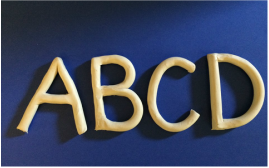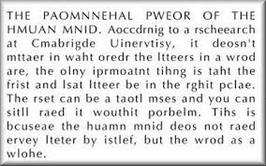The Typical Process for Learning to Read
|
When children are taught to read in their primary years of education, much emphasis is put into establishing a strong "phonemic awareness" - or, in other words, awareness of the sounds of letters and words.
This skill is certainly helpful if it can be achieved. However, students with Dyslexia will usually have difficulty with mastering phonetic instruction. A typical dyslexic student will be more apt to identify with Whole Word Recognition process for reading, but may still not be successful with reading due to perceptual distortions and confusion based on lack of mastery with letters and abstract words. |
How it works...
Phonemic AwarenessSchools generally spend a lot of time and energy in the early primary grades laying this foundation. For some children, phonics comes easily and they move into whole word recognition smoothly. For others, putting these sounds together is very difficult. There are several things which may impede them from applying what they have been taught:
New Chapter Learning can help resolve these problems and help smooth the transition towards whole word recognition and ultimately comprehension. |
Whole Word RecognitionYou may have seen this popular graphic circulating on social media sites. It is a great way to explain the idea of Whole Word Recognition while reading.
Ultimately, all successful readers use whole word recognition - ask book worms of all ages if they sound out each and every word and you will get very confused looks! "No, I look at the word and just know what it says," is the common response. Why? In the typical course of learning to read, the student will first learn phonics and eventually establish a "visual dictionary" of what the letter groups (words) look like and match those words to either the sound of the word, a picture of the meaning, or both. At the whole word recognition stage of reading, phonics is only used to decode words that are unknown (not already in the visual dictionary). Because dyslexics tend to look at words as objects from the beginning (essentially skipping the phonics stage), they become prone to identifying words by their shape, rather than "sounding out" the letters within them. Without the phonetic foundation, however, looking at the shape of the word is not reliable and causes guessing, mistakes, and confusion. The Davis® Three Steps to Easier Reading exercises provide our clients with fundamental skills that create certainty and prevent guessing. The Spell Reading, Sweep-Sweep-Spell, and Picture at Punctuation exercises were designed to improve left-right eye tracking, recognition of letter groups as words, and comprehension. |
ComprehensionOf course, the whole purpose of reading is to comprehend! Understanding, remembering, and applying the information contained in the text is the end goal for every reader.
This is where the idea of "sight words" cause a breakdown for the Dyslexic reader. What is a sight word? If we are to look at the implied meaning "sight word," it might be: "You need to recognize this word by sight - but we are not going to tell you what it means!" As picture thinkers, it stands to reason that dyslexic readers must have pictorial representation of the words they are reading. Given that 60% of any given paragraph is made up of abstract words like the, of, a, and, but, etc., it becomes easy to see how comprehension can be compromised. With no picture to process, sight words are simply blanks. No amount of rote memorization will change that fact. This problem has a very simple solution, however: create a picture for the sight words! New Chapter Learning teaches students how to create meaning for the sight words and interpret what they read by:
|





